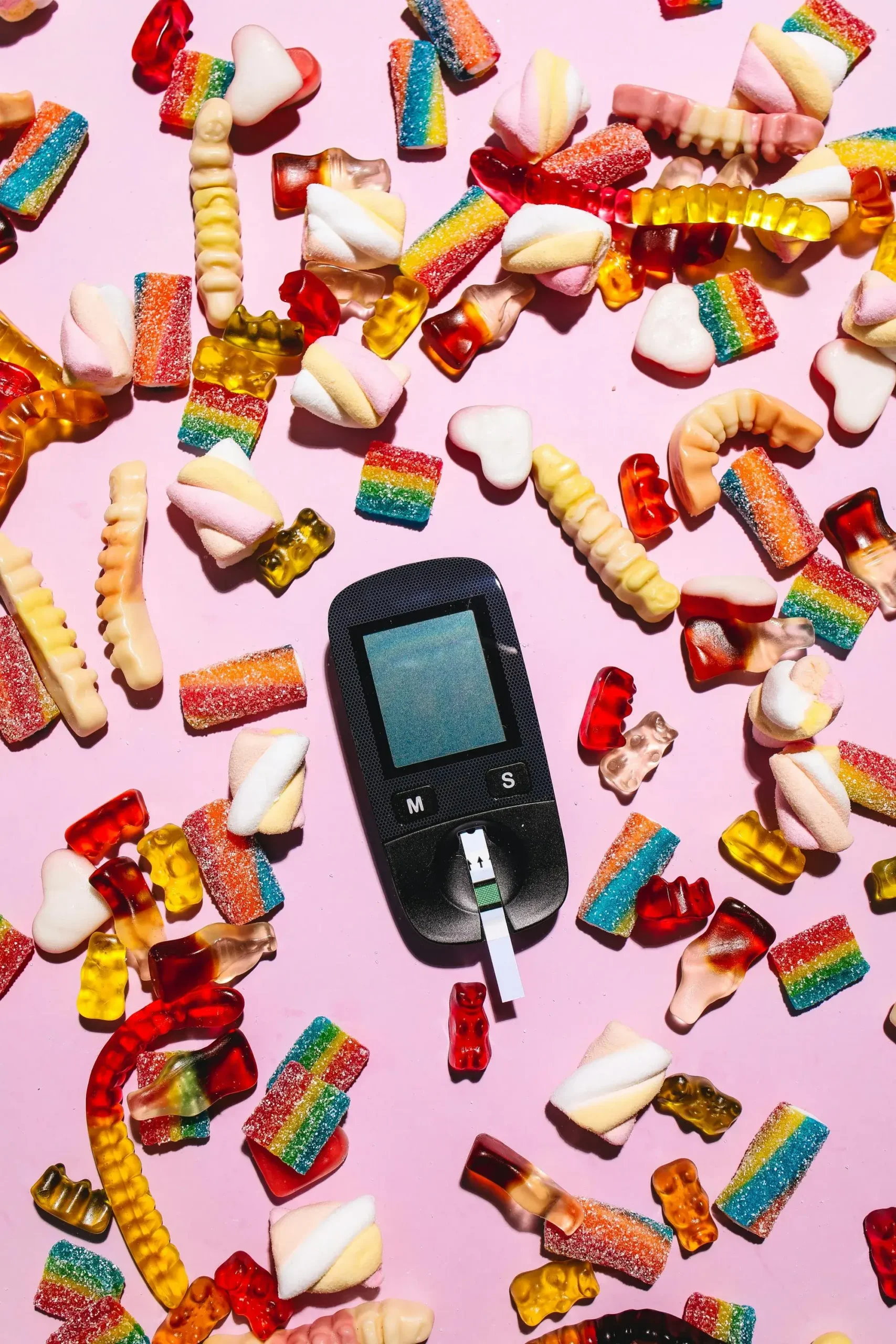What is diabetes?
Diabetes, technically called diabetes mellitus, is a medical condition where you have high blood sugar levels. It happens when your pancreas is not making enough insulin, or no insulin at all, or when your cells do not effectively respond to the insulin in your blood.
The pancreas is a large gland in your abdomen which produces digestive enzymes and certain hormones, including insulin.
Carbohydrates in your diet are broken down into simpler sugars, including glucose, which is the main source of energy for cells in your body. Glucose is then moved to the blood from your gut. After a snack or a meal, insulin from your pancreas causes the glucose to move into cells where it can be used.
A problem with the amount of insulin released or how cells respond to the insulin will cause you high blood glucose (hyperglycemia). Consistently high blood glucose can slowly damage your nerves, kidneys, blood vessels, heart and other organs.
Diabetes insipidus is an unrelated and rare condition which shares the word “diabetes”. The term “diabetes” refers to a condition which causes passing of excessive amounts of urine, a symptom present in both diabetes mellitus and diabetes insipidus.
How common is diabetes?
Worldwide, about 1 in 11 adults aged 20–79 years is living with diabetes. That is about 537 million adults living with the condition. Almost one half of the people living with diabetes do not know they have the condition.
According to the International Diabetes Federation (IDF), 1 in 8 adults will be living with diabetes by 2045.
The most common type of diabetes is type 2 diabetes.
What are the types of diabetes?
There are many forms of diabetes. The three major types are:
- Type 1 diabetes: It is an autoimmune condition where your body’s immune system destroys cells in your pancreas which makes insulin (beta cells). The reasons for the attack are not known. 5-10% of people living with diabetes have type 1 diabetes. It is more commonly diagnosed in children.
- Type 2 diabetes: Here, your body’s cells do not appropriately respond to insulin and your pancreas may also not make enough insulin. 90-95% of people living with diabetes have type 2 diabetes. It is usually diagnosed in adulthood. Prediabetes is a condition where you have higher than normal blood sugar levels, but not high enough to be diagnosed as diabetes. Prediabetes can develop into type 2 diabetes overtime.
- Gestational diabetes: It develops during pregnancy and typically goes away after the pregnancy. Having gestational diabetes increases a person’s risk of having type 2 diabetes later in life.
Other forms of diabetes include:
Latent autoimmune diabetes in adults (LADA): LADA is also called type 1.5 diabetes. It is also an autoimmune condition, like type 1 diabetes. It develops slowly and, like type 2 diabetes, it is often diagnosed in adulthood.
Type 3c diabetes: It is a form caused by any damage to the pancreas, other than autoimmune, which causes it to make and release little or no insulin.
Monogenic diabetes: It is a rare and often misdiagnosed form of diabetes caused by mutations in a single gene. This causes you to produce little insulin from your pancreas. In monogenic diabetes, the gene mutation is typically inherited from biological parents, but in rare cases may occur in its own. There are 2 main forms of monogenic diabetes:
- Maturity-onset diabetes of the young (MODY): It is the more common form and is usually diagnosed in adolescence or young adulthood. Currently, there are at least 14 known MODY mutations.
- Neonatal diabetes: It is a rare form of diabetes which occurs in the first 6 months of life. In one half of babies, the condition may persist for life and is called persistent neonatal diabetes mellitus (PNDM). In the rest of the babies, it resolves during infancy, but may reappear later in life. This type is called transient neonatal diabetes mellitus (TNDM)
What causes diabetes?
Diabetes can have many causes, depending on the type. It may be caused by:
- Autoimmune disease. Your immune system can attack and destroy your beta cells, and this causes type 1 diabetes and LADA.
- Inherited or spontaneous genetic mutations can cause monogenic diabetes.
- Certain medications. When taken for long, corticosteroids, thyroid hormone and b-adrenergic agonists (such as albuterol and terbutaline) may cause type 2 diabetes.
- Hormonal problems. Conditions like Cushing’s syndrome, hyperthyroidism and acromegaly can cause type 2 diabetes. From middle and late pregnancy, the levels of insulin-blocking hormones from the placenta increase. This can cause gestational diabetes.
- Insulin resistance is the major cause of type 2 diabetes. People with type 2 diabetes may also have reduced insulin from the pancreas. Many factors contribute to the development of insulin resistance, but the 2 main factors are: having certain genes and obesity, especially central obesity where you have excess fat tissue around your belly.
- Pancreatectomy, the surgical removal of your pancreas, can cause type 3c diabetes. Other conditions which can cause type 3c diabetes include:
- Acute or chronic pancreatitis, inflammation of the pancreas.
- Pancreatic cancer.
- Cystic fibrosis, an inherited condition which causes thick mucus to build up in your organs, including the pancreas.
- Iron overload (hemochromatosis). Excess iron may accumulate in the pancreas and destroy beta cells.
What are the symptoms of diabetes?
The general symptoms of diabetes include:
- Increased thirst
- Unintended weight loss
- Fatigue
- Blurry vision
- Frequent urination
- Increased hunger
- Sores or cuts that heal slowly
- Numbness in the feet or hands
- Unexplained muscle weakness
- Dry, itchy skin
- Frequent skin and genital infections
In type 1 diabetes, symptoms usually occur in a shorter period of time, over a few weeks or months. Type 1 diabetes is also more likely to cause a complications called diabetic ketoacidosis(DKA). DKA symptoms may include nausea, vomiting, abdominal pain and rapid breathing.
In type 2 diabetes, symptoms develop slowly over a period of years. You may even be diagnosed with type 2 diabetes before you notice any symptoms.
Usually, you will not have any symptoms if you have gestational diabetes. Routine blood sugar tests are performed on pregnant women between 24 and 28 weeks of pregnancy to detect gestational diabetes.
Who is at risk of getting diabetes?
Many factors can increase your chances of getting a certain type of diabetes.
Type 1 diabetes
You may be at increased risk if you:
- Have certain genes associated with the condition
- Have a relative with the disease
- Are infected by certain viruses like mumps or rubella
Type 2 diabetes
You may have an increased risk if you:
- Have a family history of diabetes
- Are physically inactive
- Have a personal history of gestational diabetes
- Are overweight or obese
- Have prediabetes
- Have high blood pressure
- Have high blood cholesterol levels
- Are Hispanic, African American or Asian American
- Are 45 years or older
- Have polycystic ovarian syndrome
Gestational diabetes
You are more likely to have the condition of you:
- Have given birth to a baby weighing 9 pounds (4 kg) or more before
- Have had gestational diabetes in any pregnancy before
- Have a family history of diabetes
- Are 30 years or older
- Are overweight or obese
What are the complications of diabetes?
Extreme or consistent high blood sugar levels can damage different nerves and organs throughout you body. The damage can be sudden(acute) or gradual and long-term(chronic).
Acute complications of diabetes include:
- Diabetic ketoacidosis (DKA): It is a life-threatening complication more common in people living with type 1 diabetes. When you don’t have enough insulin in your body, your cells cannot use glucose as a source of energy. So, your fat stores are broken down to provide energy. In the liver, the fatty acids formed after breakdown of fat stores are converted into substances called ketones. Ketones make your blood acidic and also give your breath a fruity smell. Other symptoms of DKA include nausea, vomiting confusion, abdominal pain, loss of consciousness and deep, rapid breathing.
- Hyperglycemic Hyperosmolar State (HHS): It is more common in people living with undiagnosed type 2 diabetes. It is a more deadly complication than DKA. In HHS, extremely high blood sugar levels cause you to frequently pass large amounts of urine. This leads to dehydration and may cause you symptoms like confusion, seizures or coma.
- Low blood sugar(hypoglycemia): It occurs in people in people who are treated with insulin or those who have diabetes-related autonomic neuropathy (nerve damage to the part of your body’s wiring system not under conscious control). Symptoms of hypoglycemia may include sweating, anxiety, dizziness, headache, blurry vision, confusion, seizures and loss of consciousness. People who have nerve damage may not notice the initial symptoms of hypoglycemia and are more likely to develop severe outcomes from it.
Chronic complications of diabetes include:
- Heart disease
- Stroke
- Nerve damage(neuropathy)
- Kidney disease(nephropathy)
- Diabetic eye disease
- Skin problems like infections, blistering and darkening
- Amputations
- Foot problems like non-healing ulcers and deformities
- Depression
Untreated gestational diabetes can also affect the baby and cause complications like:
- Stillbirth
- Respiratory problems
- Hypoglycemia
- Premature birth
- Abnormally high birth weight
- Increased chances of obesity and diabetes in the future
- Neonatal jaundice, yellowing of the skin and eyes
How is diabetes diagnosed?
You may have tests done to diagnose diabetes as part of a routine doctor’s visit, if you have symptoms or risk factors for diabetes. The tests which can be done to measure your blood glucose levels include:
- Random blood glucose test: This can be done at any time of the day. It can only be used for diagnosis if you have symptoms of diabetes.
- Fasting blood glucose test: Here, your blood glucose levels are measured after you have fasted for at least 8 hours. You may be allowed to take water during the fasting period because it does not directly affect your blood glucose levels.
- HbA1c test: This test is also called glycated hemoglobin or glycohemoglobin test. It is used to estimate your average blood sugar levels over the past 3 months.
This table shows how the results of the blood glucose tests above can be used to decide whether you have prediabetes, diabetes, or normal blood glucose levels. Your doctor will use 2 or more tests to diagnose diabetes.
[table in book]
- Oral glucose tolerance test: You are given a sugary drink after an overnight fast. Your blood sugar levels are measured at 1 hour, 2 hours, then 3 hours after taking the drink. This test is mainly used when checking for gestational diabetes in women who are 24-28 weeks pregnant.
How is diabetes treated?
The treatment of diabetes involves different steps and strategies. It may depend on the type of diabetes, the risk factors you have, how well you respond to a particular treatment, and other individual factors. Your treatment plan may involve:
Lifestyle changes
If you have type 2 diabetes, lifestyle changes alone may be enough to control your blood sugar levels. But they are important in all people living with diabetes. Lifestyle changes may include:
- Diet: Watching the amount of carbohydrate-rich foods you eat can control your blood sugar. Balancing your carbohydrate intake and your insulin doses can help you avoid complications like hypoglycemia. You still need to eat a balanced diet, consisting of small meals, to ensure that you stay healthy. A diabetes-friendly diet can also help you to lose excess weight and reduce risks for cardiovascular problems. Talk to your dietitian to help you design a meal plan that meets your needs.
- Exercise: Generally, you should engage in an aerobic activity at least 5 days a week, 30 minutes each day. Your activities can be personalized depending on what you like to do and what is accessible to you. Activities that you can do include swimming, walking, gardening, cycling or dancing. The benefits of exercise in management of diabetes include:
- Increasing sensitivity of your cells to insulin
- Reducing blood sugar levels
- Boosting mood
- Reducing risk of diabetes-related complications
Insulin
Synthetic insulin is mainly used to control blood sugar levels in people living with type 1 diabetes and LADA, but may also be helpful in people with type 2 diabetes. There are many different types of insulin and they differ in how fast they start working and how long they last in your body.
Medications
Medications can help reduce blood sugar levels if your pancreas makes enough insulin, usually in people living with prediabetes or type 2 diabetes. There are different types of anti-diabetes medications, which work in different ways. You may also need to take a combination of 2 or 3 medications to manage your blood sugars. Some common medications include metformin, glyburide, glipizide, semaglutide (Ozempic, Wegovy), canagliflozin and pioglitazone.
Regular monitoring
You can check your blood sugar levels at home with a glucose meter(glucometer) and a finger stick. Monitoring you blood sugar levels and recording them on your device or in a notebook helps your healthcare team to know how well your treatment plan is working, and when to adjust it.
Managing other conditions
When living with diabetes, it’s also important to monitor your blood pressure and cholesterol levels. High blood pressure and high cholesterol increase your chances of getting complications. Antihypertensive medications can manage your blood pressure while statins can be used to lower your blood cholesterol levels.
Surgery
Pancreas transplantation is a rare procedure where a malfunctioning pancreas is replaced by a healthy one from a deceased donor. It may be done to manage your blood sugar levels if you have type 1 diabetes and are not responding to insulin treatment. It is usually done in people who have type 1 diabetes and kidney failure but may also be done if your kidneys are functioning well.
Bariatric surgery (metabolic surgery) is a set of surgical operations where changes are made to your digestive system to help you lose weight. Your doctor may recommend bariatric surgery if your are living with diabetes and obesity which fails to respond to diet, exercise and medications. The operation may limit how much food you eat, how much food your digestive system absorbs, or both. This will cause you to lose weight, improve how well your cells respond to insulin, control blood sugar levels and reduce your risk of getting complications. You still need to maintain healthy lifestyle habits long after the surgery.
Can diabetes be prevented?
Autoimmune and genetic types of diabetes cannot be prevented.
Type 2 diabetes is caused by a complex combination of genetics, lifestyle habits, ethnicity and other conditions. You may not be able to control certain factors but you can take steps to reduce your risk of developing prediabetes and type 2 diabetes. These steps can also help you to reduce your chances of getting gestational diabetes and they include:
- Eating a healthy diet
- Stop smoking
- Reducing intake of alcoholic drinks
- Exercising regularly
- Losing weight of you are overweight or obese
- Controlling your blood pressure and blood cholesterol levels
What should I remember?
Diabetes is a serious and chronic condition that affects millions of people worldwide. However, with proper management, including a balanced diet, regular physical activity, and medication when needed, it is possible to live a healthy and fulfilling life. Early detection and consistent monitoring of blood sugar levels are crucial in preventing complications.
By staying informed and making lifestyle changes, you can significantly reduce the risks associated with this disease. Always consult with healthcare professionals for personalized advice and support.











